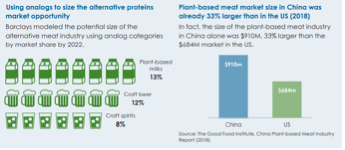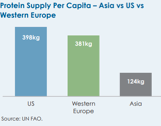Alternative proteins and the future of food in Asia
By Tai Lin on Wednesday 21 July 2021

By Tai Lin on Wednesday 21 July 2021

Tai Lin, managing partner, Proterra Investment Partners Asia, the Asian arm of the global food and agribusiness private equity fund manager Proterra Investment Partners, tells us why the Asian alternative protein market is set to explode.
There is now a significant opportunity for the sustainable food sector in Asia as the recent innovations in modern alternative proteins which have emerged in the West are beginning to take root on the continent.
We believe Asia presents an exceptional growth opportunity for the food sector, specifically in the alternative proteins category. Alongside the health and sustainability attributes of plant-based alternatives - typically lower fat and cholesterol content - there is expected to be a rapid growth in Asian consumption of alternative proteins for two important reasons: familiarity, and a demographic tailwind.
Firstly, Asia has a long history and culture associated with plant-based protein foods. For example, tofu, tempeh, yuba and soy milk already form a large part of many countries’ traditional diets and if we go back a thousand years, vegetarians in China were consuming “mock meats” made of vegetables, nuts, beans, mushrooms and gluten.
In some cases, even the underlying raw plant material used to create plant-based products is already a familiar staple food in Asia.
Additionally, Asia’s millennials and Gen-Z’s will provide a tailwind for the consumption of alternative proteins. This subsection of the population is generally better educated, more health and environmentally conscious, curious to try new things, and digital natives who are quick to catch on to global consumption trends.
They are typically more willing to spend money on high value foods. This consumption pattern is spurred by the fact millennials in Asia are out-earning their parents, and they are expected to achieve their peak earning capacity within the coming decade.


As a sector-focused investor, we continually ask ourselves which the future success stories will be? Our food strategy at Proterra Asia aims to capitalise on accelerating consumer demand that comes with growing urban populations and the emergence of a new generation of consumers looking for safe, high quality food products with attributes that meet their desires for health, nutrition, convenience, social impact and sustainability.
Our research has identified three key areas to consider when looking to invest into Asia’s food brands of the future:
We believe that creating local formats of food products matter. Western brands should be wary of copy-pasting their existing food product strategies that are working well for them in their current home markets. Creating local formats for Asia can be tricky, because Asia is a widely diverse region with different regulatory regimes and consumer preferences. A local product strategy would be “the way to go”.
Taking into account the overall lower cost points and competition, pricing will have to come down to reach a broader segment of the population. We have seen that the brands and businesses that last over the long term will be those that have a strong consumer-centric focus, alongside developing robust and efficient supply chains that will create a cost-competitive business.
Brands will also need to be differentiated as they innovate to continuously improve the products on offer and suited to the relevant local markets. The leading plant-based protein brands will be those which work to improve taste and texture (to more closely imitate animal-based equivalents), nutritional profile (e.g., through fortification, lower sodium), and other ancillary attributes (e.g., shelf life, shelf stability). Local food culture and regional preferences are important elements to consider.
This is true for all protein-food sectors and true for all of Asia, especially China. We recently announced the completion of two investments into high-growth sectors within the food industry: Simple Love (also known as Jian Ai), a premium fresh yogurt brand in China, and a newly established oat milk business out of Singapore and Indonesia. Both businesses cater to the exiting consumer preferences in their respective regions. And both can be considered to have an “R&D edge” over the overall market competition.
Cell-cultured meat is fast becoming the R&D focus among many leading food technology participants. This meat does not only imitate traditional animal-based meat, but by replicating animal cells in a nutrient rich environment that feeds the cells outside the animal can create “real” meat without animals. Cell-cultured meat is created without slaughtering animals and without potential concerns around antibiotics or microbiological contaminants.
This new industry will take more time and investments to arise due to production costs and regulatory agencies around the world needing to review and approve the product for sale to consumers. GOOD MEAT (cell-cultured chicken meat brand owned by EAT JUST) is the first cell-cultured meat product that has been approved for commercial sale in the world. It was approved by regulators in Singapore in December 2020.
While cell-cultured meat is not ready for “prime time” yet, it will be important to keep these developments in mind, as this can be a “game changer” for the whole industry in the not too distant future.
Based on the historical, cultural and demographic backdrop mentioned, we believe Asia is primed to become a key market in the creation, distribution, and consumption of alternative proteins.
2 August 2021
Paul Cuatrecasas
13 September 2021
Paul Cuatrecasas
30 June 2021
Paul Cuatrecasas
9 September 2021
David Stevenson